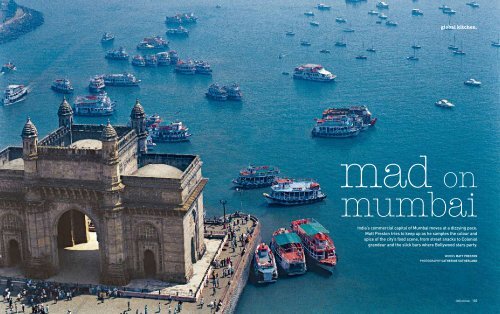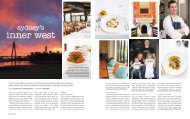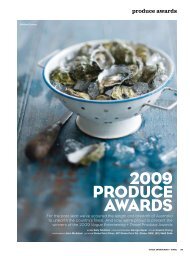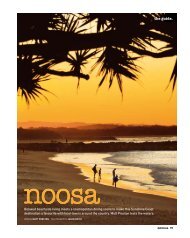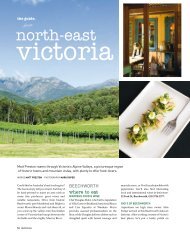You also want an ePaper? Increase the reach of your titles
YUMPU automatically turns print PDFs into web optimized ePapers that Google loves.
<strong>global</strong> <strong>kitchen</strong>.<br />
mad on<br />
mumbai<br />
India’s commercial capital of Mumbai moves at a dizzying pace.<br />
Matt Preston tries to keep up as he samples the colour and<br />
spice of the city’s food scene, from street snacks to Colonial<br />
grandeur and the slick bars where Bollywood stars party.<br />
words MATT PRESTON<br />
Photography CATHERINE SUTHERLAND<br />
delicious. 103
<strong>global</strong> <strong>kitchen</strong>.<br />
Exhilarating, infuriating and occasionally<br />
stinky, Mumbai is unlike almost any other<br />
city in the world. Live there and you’ll<br />
call it “mad Mumbai”. Visit and – after<br />
the culture shock recedes – it emerges as<br />
a vibrant and fascinating city.<br />
As the top end of India’s economy<br />
booms, the country’s commercial capital of<br />
Mumbai has never been hotter. And with<br />
direct flights from Sydney available,<br />
Mumbai is ideal for Aussies looking for a<br />
different stopover to Europe, or a holiday<br />
spot that isn’t South-East Asia.<br />
The city has its challenges. Its grandeur<br />
is a little chipped and faded, and the traffic<br />
is woeful – the 35km journey from the<br />
airport to the city centre can take three<br />
hours! This means Mumbai is very much<br />
split between North and South. The South<br />
is home to the old money, who still call the<br />
city Bombay and often belittle North<br />
Mumbai as nouveau riche due to all the<br />
Bollywood stars and models living and<br />
partying there. This division does mean,<br />
however, that there’s a high concentration<br />
of trendy clubs and bars in northern<br />
suburbs such as Juhu and Bandra, and of<br />
the 15 new five-star hotels scheduled to<br />
open in Mumbai over the next few years,<br />
the majority will be in the North.<br />
As well as the mega-wealthy and an<br />
emerging middle class, Mumbai is home to<br />
Asia’s biggest slum. It’s a measure of the<br />
poverty of the very poorest here that for<br />
them a place in a slum could be a step up<br />
from sleeping, literally, on the street. Official<br />
figures put the city’s population at about<br />
16 million, but there are estimates of another<br />
five million living there unofficially. What is<br />
dizzying is that Mumbai covers an area<br />
about a quarter the size of Melbourne or<br />
Sydney, making it the most densely<br />
populated city in the world. In spite of this,<br />
Mumbai has a reputation as a comparatively<br />
safe city, although this should not impact<br />
on the care you take when there. Mumbai<br />
also has pockets of idyllic calm, such as the<br />
ancient, temple-fringed Banganga Tank<br />
(Walkeshwar Rd, Malabar Hill), where you<br />
would believe you were in a rural village, if<br />
not for the towering skyscrapers lurking<br />
behind the crumbling old buildings.<br />
Many Indians are drawn to Mumbai by<br />
better work prospects, and the city’s role<br />
as a magnet for people from across the<br />
country means that Mumbai’s restaurants<br />
reflect a broad cross-section of cuisines.<br />
This ranges from the vegetarian food of<br />
Gujarat to the coastal Mangalorean cuisine<br />
from south of Mumbai, which exists<br />
alongside North Indian and the city’s own<br />
rather limited Maharastrian cuisine. The<br />
city’s culinary map is further complicated<br />
by distinct religious or cultural groups,<br />
including the Parsis, the Jains and the<br />
Muslims (more specifically, the Boris).<br />
Eating well in Mumbai can cost from<br />
40 rupees ($1) to 4000 ($100) but locals love<br />
all points on this scale. What follows is a<br />
free-wheeling guide to where Mumbaikars<br />
like to go. Some tourist-friendly places<br />
make it in, but only if you’re more likely to<br />
meet a Mumbaikar there than someone<br />
from Manchester or Mosman!<br />
indian finery<br />
Many of the smartest restaurants in<br />
Mumbai are in big hotels and few do Indian<br />
food as well as The Taj Mahal Palace &<br />
Tower’s Masala Kraft (see Where to Stay,<br />
+91 22 5665 3366). Snack on spiced pigeonpea<br />
cakes with tamarind and curds,<br />
followed by morel mushroom curry or<br />
pureed mustard greens with corn bread.<br />
There’s the added plus of maybe bumping<br />
into the Indian or Australian cricket teams!<br />
For North Indian dishes in similarly<br />
smart surroundings, try Kandahar (The<br />
Oberoi, Nariman Point, +91 22 5632 5757),<br />
or push past the jungled exterior into<br />
Khyber (145 Mahatma Gandhi Rd, Kala<br />
Ghoda, Colaba, +91 22 2267 3227), a Western<br />
celeb and fashionista hangout. Less swanky<br />
is Copper Chimney, a modern chain with<br />
branches in Kala Ghoda, Worli and Bandra<br />
that does good kebabs, breads, palak paneer<br />
(creamed spinach with paneer cheese), and<br />
pomfret (a local fish) in rich tomato curry.<br />
coastal cuisine<br />
With antique wooden bowls festooning the<br />
walls, the unpretentious décor at Konkan<br />
Cafe (Taj President, Cuffe Pde, Colaba, +91<br />
22 5665 0808) makes the wonderful food<br />
even more of a surprise. Specialising in the<br />
fresh, light cuisine found along the coast<br />
south of Mumbai, Konkan offers seafood,<br />
Goan mango rice, and dishes laced with<br />
pepper, coconut, garlic, ginger and spices.<br />
Winners include prawns with garlic and<br />
pepper; pomfret steamed in tamarind<br />
leaves; and a dizzying array of vegetable<br />
dishes. They also have a decent wine list<br />
dotted with a few drinkable Indian wines.<br />
Mahesh Lunch House (8B Cawasji Patel<br />
St, Fort, +91 22 2287 0938) is also a popular<br />
haunt for seafood, but for more adventure,<br />
head north to Gajalee (Kadamgiri Complex,<br />
Hanuman Rd, Vile Parle, +91 22 2611 4093).<br />
Have a candy-pink drink made from a<br />
sweet-sour fruit called kokum, and gorge on<br />
crispy fried bombil (lizardfish or ‘Bombay<br />
duck’) with green chilli and coriander, and<br />
One of the many vendors<br />
at Juhu Beach. Opposite,<br />
from top: the opulent<br />
Tsar vodka bar at the<br />
InterContinental; making<br />
marigold garlands at<br />
Colaba Market.<br />
succulent giant prawns cooked in the<br />
tandoor. Choose between air-conditioned<br />
or the cheaper ‘no air-con’ room. Once this<br />
far north, you might as well also visit the<br />
bars of Juhu and Bandra.<br />
As Mumbai covers seven islands, it’s not<br />
surprising that seafood is big news here.<br />
In the early morning, go to Ferry Wharf in<br />
Mazagaon to see the fish land: pomfret,<br />
bombil, lobster, prawns or surmai (a bit like<br />
kingfish). It’s a crazy, heaving, technicolour<br />
maelstrom of people. Fish pour from boats<br />
onto the slurry of the dock where manic<br />
bidding ensues. Three tips: don’t wear<br />
thongs; be careful what you take pictures of<br />
(as this is a sensitive naval area); and if you<br />
hear hissing behind you, it’s a porter’s way<br />
of saying they’re coming past – at speed!<br />
The city’s most loved seafood restaurant<br />
is dinky little Trishna (Sai Baba Marg, Kala<br />
Ghoda, Fort, +91 22 2270 3213). Book a<br />
crammed padded bench, order a Kingfisher<br />
beer, then move on to Hyderabadi tikka of<br />
pomfret, a justified bestseller. As with most<br />
places in this city, a dish of onions and fresh<br />
limes is on hand to freshen the palate.<br />
delicious. 105
<strong>global</strong> <strong>kitchen</strong>.<br />
vegging out<br />
Another must-do is a Gujarati thali (a large<br />
tray with bread, rice and a variety of side<br />
dishes) from the vegetarian state that<br />
lies north of Mumbai. The long-running<br />
Rajdhani (361 Sheikh Memon St, Fort, +91<br />
22 2342 6919) is a narrow shopfront lost<br />
among the hubbub of fabric sellers. A sign<br />
declares they’ve served more than 5.5<br />
million thalis. Here, a metal tray is loaded<br />
with little pots of pulses, spiced cauliflower<br />
florets, or a sweet yellow sauce full of<br />
drumsticks (a green seed pod) which are<br />
chewed with the stalky casing, then spat<br />
out. Everything is constantly replenished,<br />
courtesy of the manager communicating<br />
through finger clicks. Other venerable thali<br />
choices are Golden Star Thali (330 Raja<br />
Ram Mohan Roy Rd, Chowpatty, +91 22<br />
2363 1983) or Chetana (34 K.Dubash Marg,<br />
Kala Ghoda, +91 22 2284 4968).<br />
Also, explore Mumbai’s warren-like<br />
Crawford Market to see the local produce,<br />
then visit the 100-year-old BadShah<br />
(152/156 LT Marg, opp. Crawford Market,<br />
Fort, +91 22 2342 1943) for hand-churned<br />
kulfi (ice cream) or falooda, a slippery,<br />
slurpable vermicelli dessert in flavours<br />
such as rosewater or saffron.<br />
a taste of persia<br />
With a history of philanthropy far<br />
outweighing their numbers, members of<br />
Mumbai’s Parsi community have also<br />
contributed culinary gifts to the city.<br />
Zoroastrians, who left Persia 1000 years<br />
ago, have a cuisine that hints at<br />
their geographic past. The 90-year-old<br />
Britannia & Co (Wakefield House, 11<br />
Sprott Rd, Ballard Estate, Fort, +91 22<br />
2261 5264) is one of only a few so-called<br />
Irani cafes left in Mumbai, and is widely<br />
regarded as the best. Try patrani machchi<br />
(steamed pomfret with spiced coriander<br />
paste), or mutton dhansak with berry<br />
pulao – a mutton rice dish with tart<br />
Iranian barberries. Wash it all down in<br />
true Parsi fashion with a raspberry soda.<br />
Afterwards, wander over to Yazdani<br />
Bakery (11 Cawasji Patel St, Fort, +91 22<br />
2287 0739) to complete your feast with fiery<br />
ginger biscuits and bun maska, a buttered<br />
fruit bun that’s perfect with milky chai.<br />
street bites<br />
Mumbai loves to graze, as you’ll discover if<br />
you join the thousands ambling along<br />
Chowpatty and Juhu beaches. Along with<br />
balloon sellers, neon-pink fairy floss and<br />
man-powered fairground rides, you’ll find<br />
gaudy stalls offering tasty snacks. The best<br />
is pani puri (crispy pastry with potato,<br />
spices and tamarind water), but it’s even<br />
better as dahi puri topped with curds and<br />
roasted vermicelli. Another favourite is pav<br />
bhaji – a mess of diced vegetables cooked<br />
on a huge, thick metal chargrill served with<br />
a sweet bun and a lashing of melted butter.<br />
Eating from street stalls can be a risk for<br />
Western stomachs given the different<br />
standards of hygiene, refrigeration and<br />
water quality. There are no hard and fast<br />
rules for not becoming sick, but the basics<br />
are to eat where loads of locals go<br />
(preferably with a local as a guide); eat food<br />
that’s cooked at a high heat and cooked<br />
through; and avoid eating at dirty places.<br />
Dahi puri, a pastry street<br />
snack with potato, spices<br />
and yoghurt. Clockwise<br />
from below: colourful<br />
vendors at Chowpatty<br />
Beach; bustling traffic<br />
at Crawford Market; the<br />
gothic architecture of<br />
Victoria Terminus station;<br />
a boy takes to the stove<br />
at a Juhu street stall.<br />
A safer option for visitors is to dine at the<br />
swag of cafes serving street favourites.<br />
A kilometre north of Chowpatty Beach,<br />
queue for a table at pav bhaji pioneer Sardar<br />
(166B M. Malviya Marg, Tardeo Rd Jct,<br />
+91 22 2353 0208). For Gujarati and South<br />
Indian snacks, try Soam (Sadguru Sadan,<br />
opp. Babulnath Mandir, Chowpatty, +91 22<br />
2369 8080) or Swati Snacks (248 Karai<br />
Estate, Tardeo Rd, opp. Bhatia Hospital,<br />
Tardeo, + 91 22 2492 0994). With its newish<br />
industrial look of stainless steel, Swati is<br />
the least swank but nonetheless loved by<br />
office workers and lunching ladies alike.<br />
This 40-year-old veteran is famous for its<br />
panki, a steamed banana-leaf pancake with<br />
spicy green chutney. First thing each<br />
morning, they also make syrup-soaked,<br />
deep-fried batter squiggles called jalebi.<br />
The quintessential Mumbai breakfast,<br />
however, is vada pav (a fried potato fritter<br />
served in a roll with spicy chutney).<br />
Invented 35 years ago by a street seller at<br />
Dadar station, locals now argue about<br />
whether the best comes from Panshikar’s<br />
(2 Govardhandas Building, JSS Rd, +91 22<br />
2386 1211), Krishna Vada Pav near the<br />
station, the vada pavwallah at Kirti College,<br />
or from Prakash (Gokhale Rd, Dadar).<br />
The most famous street stall in<br />
Mumbai’s south is the buzzy Bade Miya<br />
(Tulloch Rd, Apollo Bunder, +91 22 2284<br />
8038), located in a dingy alley behind the<br />
Taj Mahal Palace, where its charcoal<br />
barbecues line the pavement. Each night,<br />
a jam of cars pull up to order kebabs of<br />
ground mutton or beef with swathes<br />
of ‘handkerchief’ bread.<br />
One powerful culinary icon that is<br />
slipping from the streets of Mumbai is the<br />
dabbawallah. This extraordinary, intricate<br />
network of lunch delivery men used to<br />
bring over 200,000 lunches from suburban<br />
housewives to their working husbands in<br />
the city, but with more dual-income<br />
homes, the number of takeaways is<br />
increasing and the number of women<br />
cooking lunches for their spouses is<br />
waning, together with employment<br />
opportunities for dabbawallahs. They’re<br />
not gone yet though, so you can still see<br />
them at Chhatrapati Shivaji Terminus at<br />
11.30am every weekday.<br />
delicious. 107
<strong>global</strong> <strong>kitchen</strong>.<br />
the melting pot<br />
Affluent Mumbaikars love foreign food as<br />
much as any other big city urbanite, with<br />
Japanese and Italian being the flavours of<br />
the month. US celebrity (and Iron Chef)<br />
Masaharu Morimoto was consulted in the<br />
opening of the sleek Wasabi (Taj Mahal<br />
Palace, Colaba, +91 22 5665 3366), and its<br />
sharp, modern Japanese menu. Stylish<br />
Vetro (The Oberoi, Nariman Point, +91 22<br />
6632 6215) stays at the top of the Italian<br />
pack with its walls of swivelling coloured<br />
glass panels and dishes such as San Daniele<br />
prosciutto with rockmelon and Amarone (a<br />
dry Italian red wine) reduction; and squidink<br />
tagliolini with baby lobster.<br />
The city has also had a long-running love<br />
affair with Chinese food. Try the ornate,<br />
split-level Ming Yang (Taj Lands End, Band<br />
Stand, Bandra, +91 22 6668 1234) with its<br />
sea views, or Henry Tham (Dhanraj Mahal,<br />
Apollo Bunder, +91 22 2202 3186) for quirky<br />
mod furniture and seven-course banquets.<br />
(It turns into a bit of a nightclub later).<br />
Another for the itinerary is Thai Pavilion<br />
(Taj President, Cuffe Pde, Colaba, +91 22<br />
6665 0808), which has a sexy new look<br />
from Japanese design firm Super Potato,<br />
combining minimalist lines with walls of<br />
intricately-patterned purdah (screen) panels<br />
and a slatted patchwork of carved beams.<br />
Expect precisely worked Thai dishes of<br />
whole fish baked in clay or pomelo salad.<br />
If design is your god as much as modern<br />
food, then the cool off-white interior of<br />
Pure (Taj Lands End, Bandra, Band Stand,<br />
+91 22 6668 1234) might also be your thing.<br />
With a focus on organic ingredients, young<br />
US chef Joshua Kemper whips up grilled<br />
Himalayan trout on mango wood, or<br />
tender sous-vide (vacuum-cooked) lobster.<br />
In Colaba, chef Rahul Akerkar has become<br />
an Indian celebrity for his take on modern<br />
cuisine and décor at Indigo (4 Mandlik Rd,<br />
Colaba, +91 22 5636 8999) with its rooftop<br />
lounge, cocktail bar and menu of modern<br />
international flavours.<br />
restobars rising<br />
Restobars (restaurants that morph into<br />
bars), like Indigo, are big news for young<br />
Mumbaikars. In Colaba, couples go to Taxi<br />
(Jony Castle Building, 92 Khatau Rd, off<br />
Wodehouse Rd, Colaba, +91 22 2218 4904),<br />
with its intentionally disheveled old Euro<br />
interior, to smoke hookahs (water pipes),<br />
drink beers or snack. Other options include<br />
the notorious knock-about travellers bar<br />
Leopold Café (Colaba Causeway, + 91 22<br />
2287 3362) for icy cold beer and a menu<br />
that ranges from chicken tikka to steak<br />
and eggs, or hanging out at the far cooler<br />
Busaba (4 Mandlik Rd, Colaba, +91 22<br />
2204 3779), with its Thai-tinged food.<br />
After visiting Chowpatty Beach, or as<br />
a break from the mayhem of the cricket at<br />
The ornate interior of<br />
Thai Pavilion. Above,<br />
from left: Modern Italian<br />
Vetro stands out from<br />
the crowd; a dabbawallah<br />
ferries lunch to office<br />
workers in tiffin boxes.<br />
nearby Wanhkede or Brabourne stadia,<br />
try Dome (InterContinental Hotel, 135<br />
Marine Pde, +91 22 3987 9999). This white<br />
rooftop oasis attracts a swish crowd for<br />
sushi, a strong list of imported whiskies,<br />
and a stunning dusk view of the lights<br />
that form the Queen’s Necklace around<br />
Marine Drive. Downstairs there’s Tsar, a<br />
lushly decorated vodka bar that attracts a<br />
younger crowd. If you’re extra peckish,<br />
nip upstairs to Kebab Corner – the hotel’s<br />
family Indian restaurant, which grew up<br />
from a street stall like Bade Miya.<br />
108 delicious.
<strong>global</strong> <strong>kitchen</strong>.<br />
For a more raucous time, head up to the<br />
suburb of Worli and go to the Bombay<br />
Dyeing Mill Compound on Pandurang<br />
Budhkar Marg. Here you’ll find supercool<br />
bar Shiro (+91 22 2438 3008), with its<br />
monumental sculptures, day beds for<br />
lounging on and a light, Chinese-accented<br />
menu. Next door is the far daggier but<br />
pumping Hard Rock Cafe (+91 22 2438<br />
2888), where it’s a slightly intoxicating<br />
cultural disconnect to find yourself<br />
punching the air to Eye of the Tiger with a<br />
room full of 300 drunk locals.<br />
Further north, join the cricketers, celebs<br />
and Bollywood types at Juhu beach’s<br />
restobars, such as Vie Lounge (102, Roop<br />
Leela Bungalow, Juhu Tara Rd, Santa<br />
Cruz, +91 22 2660 3003) or Aurus (Nichani<br />
Kutir, Juhu Tara Rd, Juhu, +91 22 6710<br />
6666). While you’re in Bandra, there’s the<br />
mod-Med menu of the rather slick Olive<br />
Bar & Kitchen (14 Union Park, Khar, +91<br />
22 2600 8248) or the Japanese-inspired<br />
look of Seijo and the Soul Dish (206,<br />
Krystal, Waterfield Rd, Bandra, +91 22<br />
2640 5555), which has an Asian-tinged<br />
Pacific Rim fusion menu.<br />
cafe fare<br />
For a light meal or something earlier in<br />
the day, call into Rahul Akerkar’s<br />
extension of his Indigo concept, Indigo<br />
Deli (Pheroze Building, Chhatrapati<br />
Shivaji Maharshi Marg, Apollo Bunder,<br />
+91 22 6655 1010). This modern, produceled<br />
cafe wouldn’t be out of place in Surry<br />
Hills or South Yarra. If nothing else, come<br />
for their chorizo pizza with its crisp,<br />
wafer-thin base, or the lime tart. For a<br />
similar cafe-cum-wine bar feel, visit<br />
Moshe’s (7 Minoo Manor, Cuffe Pde,<br />
Colaba, +91 22 2216 1226).<br />
For coffee, try Barista with its branches<br />
in Bandra, Cuffe Parade and Chowpatty,<br />
although the swish and rather old-school<br />
Sea Lounge (The Taj Mahal Palace &<br />
Tower, see Where to Stay) is a far calmer<br />
experience. Gloss over 23 single-origin<br />
coffees in favour of a pot of tea from a<br />
selection of 41, ranging from Assam and<br />
Darjeeling to high-grown Nilgiri. And<br />
keep an eye out for aristocratic youth out<br />
on parentally sanctioned first dates.<br />
where to stay<br />
With its unrivalled history and tradition<br />
matched to an impeccable location next to<br />
the grand Gateway of India arch, the The<br />
Taj Mahal Palace & Tower (Apollo Bunder,<br />
Colaba, +91 22 6665 3366, tajhotels.com)<br />
is one of the few hotels in the world whose<br />
architecture has become part of the<br />
iconography of its city. This opulent hotel,<br />
with its luxury shopping arcades, garden<br />
and pool, is a Victorian oasis. If you can<br />
afford it, stay in the far more atmospheric<br />
old wing, rather than the modern tower.<br />
Slightly less regal but still very<br />
comfortable, the Taj President (90 Cuffe<br />
Pde, Colaba, +91 22 6665 0808) boasts a<br />
funky cocktail bar, Wink. It’s home to two<br />
of the city’s best places to eat (Konkan Cafe<br />
and Thai Pavilion) and high-flying Indian<br />
chef Ananda Soloman, a leading expert on<br />
India’s regional cuisines. The English<br />
cricket team is known to be partial to the<br />
Trattoria’s pizzas, too.<br />
Lastly, Mumbai’s addresses can be tricky,<br />
as every street has a colonial and an Indian<br />
name. For a great map, visit: hoteltravel.<br />
com/india/mumbai/central_map.htm. If<br />
in doubt, ask your concierge or a local to<br />
check the address and convey it to the<br />
driver of a black and yellow taxi. d.<br />
Thanks to Taj Hotels Resorts and Palaces and<br />
Qantas Airways for assistance with this story.<br />
Qantas flies Sydney to Mumbai three times<br />
weekly, tel: 13 13 13, visit: qantas.com.au.<br />
A Victorian oasis at The Taj Mahal<br />
Palace & Tower. Above: the minimalist<br />
white interior of organic fusion<br />
restaurant, Pure, at Taj Lands End.<br />
110 delicious.


